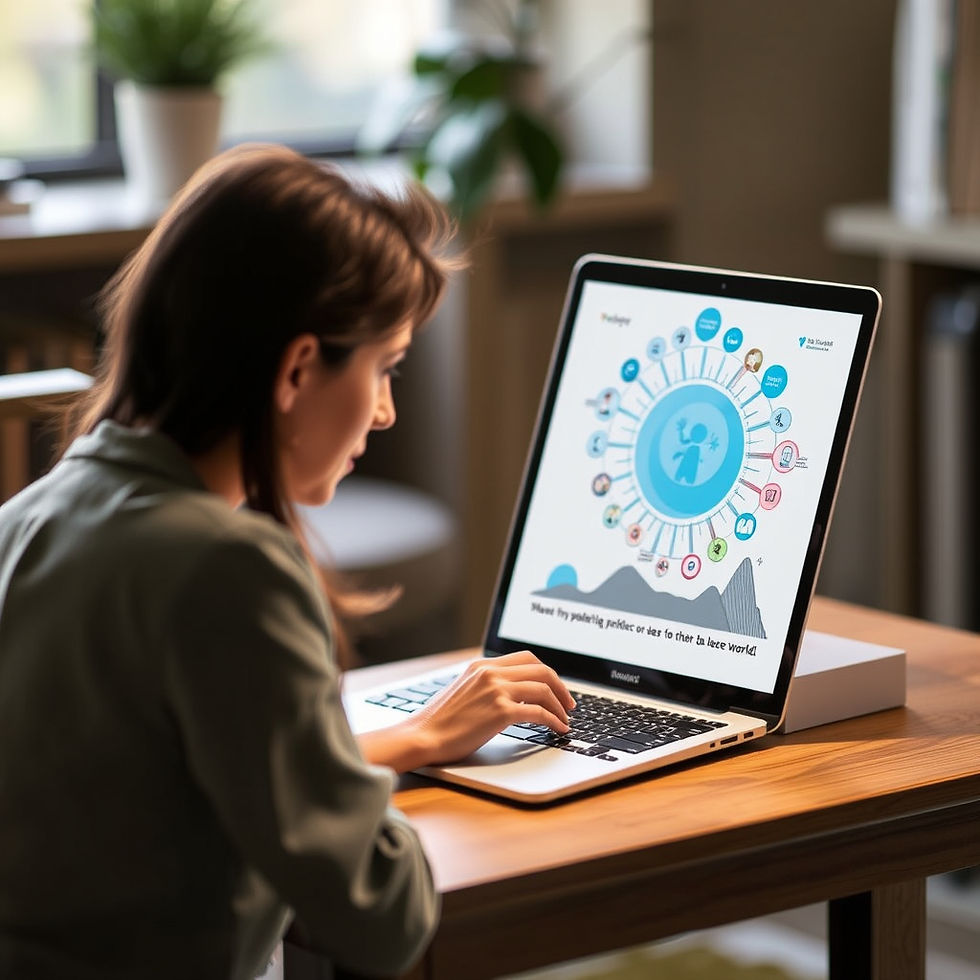Mastering Digital Wellbeing: Finding Balance in a Connected World
- Saeed Ebadzadeh
- Jul 11
- 4 min read
Updated: Jul 12

Hello again, Nexis-SEM community!
Following our introduction, for our second post, let’s dive into a crucial aspect of modern life: Digital Wellbeing. In a world increasingly dominated by screens and constant connectivity, finding a healthy balance with technology is more important than ever for our mental and physical health, as well as our personal growth.
Think about how many hours a day you spend looking at a screen – your phone, your computer, your TV. While these devices offer incredible opportunities for learning, connection, and entertainment, excessive use can lead to stress, sleep disturbances, decreased productivity, and even feelings of isolation.
Why is Digital Wellbeing Important?
Just like any powerful tool, technology requires conscious and mindful usage. Neglecting our digital wellbeing can have significant impacts:
Mental Health: Constant notifications and social media comparisons can fuel anxiety and lower self-esteem.
Physical Health: Prolonged sitting, eye strain, and disrupted sleep patterns are common consequences of over-reliance on devices.
Productivity: Distractions from notifications and endless scrolling can severely hinder our ability to focus and accomplish tasks.
Relationships: Spending too much time online can detract from real-life interactions and connections.
Tips for Cultivating Digital Wellbeing:
Here are some actionable strategies to help you find a healthier relationship with technology:
Set Intentional Screen-Free Times: Designate specific periods each day where you consciously avoid all screens, such as during meals, for an hour before bed, or during family time.
Manage Notifications: Turn off non-essential notifications on your phone and computer. Check apps and emails at scheduled times rather than being constantly interrupted.
Create Tech-Free Zones: Establish areas in your home, like your bedroom, where devices are not allowed.
Practice Mindful Usage: Be aware of why you are reaching for your phone or computer. Are you being productive, connecting meaningfully, or just mindlessly scrolling?
Prioritize Real-World Activities: Make time for hobbies, exercise, and spending quality time with loved ones, activities that nourish your wellbeing offline.
Use Apps to Track and Limit Usage: Several apps can help you monitor your screen time and set limits for specific applications.
Be Mindful of Social Media Consumption: Follow accounts that inspire and uplift you. Limit exposure to content that makes you feel negative or inadequate.
Cultivating digital wellbeing is an ongoing process, not a destination. By making small, conscious adjustments to our habits, we can harness the benefits of technology without letting it negatively impact our lives.
What are your strategies for maintaining digital wellbeing? Share your tips in the comments below!
Saeed Ebadzadeh Mosadegh
تسلط بر رفاه دیجیتال: یافتن تعادل در دنیای متصل
سلام دوباره به جامعه Nexis-SEM!
در ادامه معرفی، برای دومین پست خود، بیایید به جنبهای حیاتی از زندگی مدرن بپردازیم: رفاه دیجیتال. در دنیایی که بهطور فزایندهای تحت سلطه صفحههای نمایش و اتصال دائمی قرار دارد، یافتن تعادل سالم با فناوری بیش از هر زمان دیگری برای سلامت روانی و جسمی و همچنین رشد شخصی ما اهمیت دارد.
به این فکر کنید که چند ساعت در روز را صرف نگاه کردن به صفحه نمایش میکنید – تلفن، رایانه، تلویزیون. در حالی که این دستگاهها فرصتهای باورنکردنی برای یادگیری، ارتباط و سرگرمی ارائه میدهند، استفاده بیش از حد میتواند منجر به استرس، اختلالات خواب، کاهش بهرهوری و حتی احساس انزوا شود.
چرا رفاه دیجیتال مهم است؟
درست مانند هر ابزار قدرتمند دیگری، فناوری نیازمند استفاده آگاهانه و هوشمندانه است. نادیده گرفتن رفاه دیجیتال ما میتواند تأثیرات قابل توجهی داشته باشد:
سلامت روان: اعلانهای مداوم و مقایسه خود با دیگران در رسانههای اجتماعی میتواند اضطراب را تشدید کرده و عزت نفس را کاهش دهد.
سلامت جسمی: نشستن طولانی مدت، فشار چشم و اختلال در الگوهای خواب از پیامدهای رایج وابستگی بیش از حد به دستگاهها هستند.
بهرهوری: حواسپرتی ناشی از اعلانها و گشت و گذار بیپایان میتواند به شدت توانایی ما در تمرکز و انجام وظایف را مختل کند.
روابط: صرف زمان زیاد آنلاین میتواند از تعاملات و ارتباطات واقعی در زندگی بکاهد.
نکاتی برای پرورش رفاه دیجیتال:
در اینجا چند استراتژی عملی برای کمک به شما در یافتن رابطه سالمتر با فناوری آورده شده است:
تعیین زمانهای بدون صفحه نمایش عمدی: دورههای خاصی را در هر روز تعیین کنید که در آن به طور آگاهانه از تمام صفحههای نمایش اجتناب کنید، مانند زمان غذا خوردن، یک ساعت قبل از خواب یا در طول وقت خانوادگی.
مدیریت اعلانها: اعلانهای غیرضروری را در تلفن و رایانه خود خاموش کنید. برنامهها و ایمیلها را در زمانهای برنامهریزیشده بررسی کنید نه اینکه دائماً وقفه ایجاد شود.
ایجاد مناطق عاری از فناوری: مناطقی را در خانه خود، مانند اتاق خواب، تعیین کنید که در آن دستگاهها مجاز نیستند.
تمرین استفاده آگاهانه: از دلیل برداشتن تلفن یا رایانه خود آگاه باشید. آیا سازنده هستید، ارتباط معناداری برقرار میکنید یا فقط بیهدف در حال گشت و گذار هستید؟
اولویت دادن به فعالیتهای دنیای واقعی: برای سرگرمیها، ورزش و گذراندن وقت با کیفیت با عزیزان، فعالیتهایی که رفاه شما را به صورت آفلاین تغذیه میکنند، وقت بگذارید.
استفاده از برنامهها برای ردیابی و محدود کردن استفاده: چندین برنامه میتوانند به شما در نظارت بر زمان صفحه نمایش و تعیین محدودیت برای برنامههای خاص کمک کنند.
آگاه بودن از مصرف رسانههای اجتماعی: حسابهایی را دنبال کنید که الهامبخش و نشاطآور هستند. قرار گرفتن در معرض محتوایی که باعث احساس منفی یا ناکافی بودن شما میشود را محدود کنید.
پرورش رفاه دیجیتال یک فرآیند مداوم است، نه یک مقصد. با ایجاد تغییرات کوچک و آگاهانه در عادات خود، میتوانیم از مزایای فناوری بهرهمند شویم بدون اینکه اجازه دهیم تأثیر منفی بر زندگی ما بگذارد.
استراتژیهای شما برای حفظ رفاه دیجیتال چیست؟ نکات خود را در بخش نظرات زیر به اشتراک بگذارید!
سعید عبادزاده مصدق









תגובות